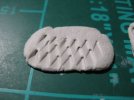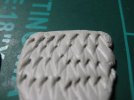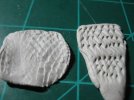Patrick: It is much harder to do than I origionally thought. Part of my problem is that the different putties I am trying to use: Aves, bondo, and squadron white. Have trouble taking the detail when they are in a thin film. I can replicate the pattern on a thick flat sheet of aves:



And one last photo of my sculpt next to a texture stamp that I made:

As you can see my textures are way larger than those on the model
With the flat sheet, the Aves has room to squish underneath my sculpting tool. But it can't do that on the piece. In addition, the texture on the model is no where as deep as I have done on the flat sheet of aves.
I have also been experimenting with curing time, for example Aves will take a texture better after it has been sitting for a few hours, rather than when it is first mixed up. In part I need to get the variables straight. Once I do, I think I will get it figured out, or maybe try a different putty.
Norm: Thank you for the video! It has given me ideas and brought up a few questions. I have never worked with resin before. (I have made one resin model.) From my limited experience, resin is brittle. These parts are very curved. Would I be able to flex it around a curved surface? Or would my "mold" have to be curved like the part?
You have given me an idea, how about taking that molding compound that I used for the feet, making a negative like you did in your video and then using aves for the thin "skin" it cures slowly and if I let it sit for a few hours it might take the texture and still be soft enough to attach to the model.
I also thought of a different type of texture stamp other than what I was using. One that is more like a stamp than a flat sheet to wrap around. I am also thinking of cutting up a thick sheet of styrene to make up a new texture tool. Part of my problem is the sculpting tool I am using isn't quite the same as this texture.
And Norm, criticism is always welcome!!! It doesn't hurt it helps!




